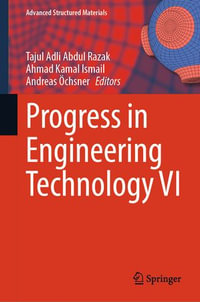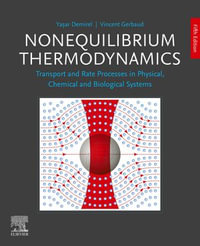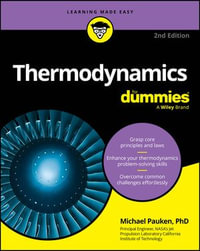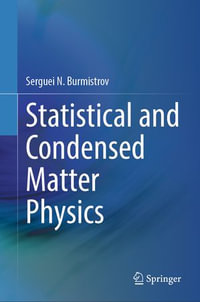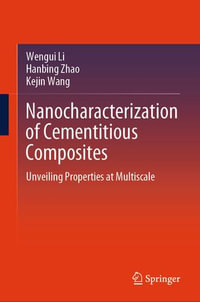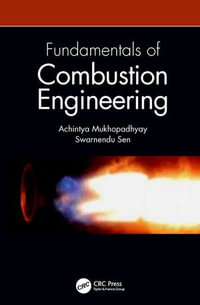
eTEXT
Drying Phenomena: Theory and Applications
Theory and Applications
By: Ibrahim Dincer, Calin Zamfirescu
eText | 22 October 2015 | Edition Number 1
At a Glance
ePUB
eText
$197.99
or 4 interest-free payments of $49.50 with
orInstant online reading in your Booktopia eTextbook Library *
Read online on
Not downloadable to your eReader or an app
Why choose an eTextbook?
Instant Access *
Purchase and read your book immediately
Read Aloud
Listen and follow along as Bookshelf reads to you
Study Tools
Built-in study tools like highlights and more
* eTextbooks are not downloadable to your eReader or an app and can be accessed via web browsers only. You must be connected to the internet and have no technical issues with your device or browser that could prevent the eTextbook from operating.
Comprehensively covers conventional and novel drying systems and applications, while keeping a focus on the fundamentals of drying phenomena.
- Presents detailed thermodynamic and heat/mass transfer analyses in a reader-friendly and easy-to-follow approach
- Includes case studies, illustrative examples and problems
- Presents experimental and computational approaches
- Includes comprehensive information identifying the roles of flow and heat transfer mechanisms on the drying phenomena
- Considers industrial applications, corresponding criterion, complications, prospects, etc.
- Discusses novel drying technologies, the corresponding research platforms and potential solutions
Read online on
Preface xi
Nomenclature xv
1 Fundamental Aspects 1
1.1 Introduction 1
1.2 Fundamental Properties and Quantities 2
1.3 Ideal Gas and Real Gas 13
1.4 The Laws of Thermodynamics 19
1.5 Thermodynamic Analysis Through Energy and Exergy 24
1.5.1 Exergy 24
1.5.2 Balance Equations 27
1.6 Psychometrics 36
1.7 Heat Transfer 45
1.7.1 General Aspects 45
1.7.2 Heat Transfer Modes 48
1.7.3 Transient Heat Transfer 54
1.8 Mass Transfer 58
1.9 Concluding Remarks 63
1.10 Study Problems 63
References 65
2 Basics of Drying 67
2.1 Introduction 67
2.2 Drying Phases 68
2.3 Basic Heat and Moisture Transfer Analysis 69
2.4 Moist Material 76
2.5 Types of Moisture Diffusion 81
2.6 Shrinkage 82
2.7 Modeling of Packed-Bed Drying 86
2.8 Diffusion in Porous Media with Low Moisture Content 88
2.9 Modeling of Heterogeneous Diffusion in Moist Solids 90
2.10 Conclusions 97
2.11 Study Problems 97
References 98
3 Drying Processes and Systems 99
3.1 Introduction 99
3.2 Drying Systems Classification 100
3.3 Main Types of Drying Devices and Systems 105
3.3.1 Batch Tray Dryers 105
3.3.2 Batch Through-Circulation Dryers 106
3.3.3 Continuous Tunnel Dryers 108
3.3.4 Rotary Dryers 110
3.3.5 Agitated Dryers 114
3.3.6 Direct-Heat Vibrating-Conveyor Dryers 116
3.3.7 Gravity Dryers 117
3.3.8 Dispersion Dryers 119
3.3.9 Fluidized Bed Dryers 128
3.3.10 Drum Dryers 130
3.3.11 Solar Drying Systems 132
3.4 Processes in Drying Systems 137
3.4.1 Natural Drying 137
3.4.2 Forced Drying 145
3.5 Conclusions 151
3.6 Study Problems 151
References 152
4 Energy and Exergy Analyses of Drying Processes and Systems 153
4.1 Introduction 153
4.2 Balance Equations for a Drying Process 154
4.3 Performance Assessment of Drying Systems 159
4.3.1 Energy and Exergy Efficiencies 159
4.3.2 Other Assessment Parameters 161
4.4 Case Study 1: Analysis of Continuous-Flow Direct Combustion Dryers 162
4.5 Analysis of Heat Pump Dryers 169
4.6 Analysis of Fluidized Bed Dryers 178
4.6.1 Hydrodynamics of Fluidized Beds 179
4.6.2 Balance Equations 181
4.6.3 Efficiency Formulations 183
4.7 Conclusions 187
4.8 Study Problems 187
References 188
5 Heat and Moisture Transfer 189
5.1 Introduction 189
5.2 Transient Moisture Transfer During Drying of Regularly Shaped Materials 190
5.2.1 Transient Diffusion in Infinite Slab 191
5.2.2 Drying Time of an Infinite Slab Material 200
5.2.3 Transient Diffusion in an Infinite Cylinder 202
5.2.4 Transient Diffusion in Spherical-Shape Material 205
5.2.5 Compact Analytical Solution or Time-Dependent Diffusion in Basic Shapes 208
5.3 Shape Factors for Drying Time 209
5.3.1 Infinite Rectangular Rod of Size 2L × 2?1L 210
5.3.2 Rectangular Rod of Size 2L × 2?1L×2?2L 210
5.3.3 Long Cylinder of Diameter 2L and Length 2?1L 212
5.3.4 Short Cylinder of Diameter 2?1L and Length 2L 213
5.3.5 Infinite Elliptical Cylinder of Minor Axis 2L and Major Axis 2?1L 213
5.3.6 Ellipsoid Having the Axes 2L, 2?1L, and 2?2L 213
5.4 Moisture Transfer Coefficient and Diffusivity Estimation from Drying Curve 216
5.5 Simultaneous Heat and Moisture Transfer 219
5.6 Models for Heat and Moisture Transfer in Drying 225
5.6.1 Theoretical Models 226
5.6.2 Semitheoretical and Empirical Models for Drying 231
5.7 Conclusions 232
5.8 Study Problems 233
References 234
6 Numerical Heat and Moisture Transfer 237
6.1 Introduction 237
6.2 Numerical Methods for PDEs 239
6.2.1 The Finite Difference Method 240
6.2.2 Weighted Residuals Methods: Finite Element, Finite Volume, Boundary Element 246
6.3 One-Dimensional Problems 249
6.3.1 Decoupled Equations with Nonuniform Initial Conditions and Variable Boundary Conditions 249
6.3.2 Partially Coupled Equations 253
6.3.3 Fully Coupled Equations 256
6.4 Two-Dimensional Problems 261
6.4.1 Cartesian Coordinates 261
6.4.2 Cylindrical Coordinates with Axial Symmetry 271
6.4.3 Polar Coordinates 276
6.4.4 Spherical Coordinates 280
6.5 Three-Dimensional Problems 284
6.6 Influence of the External Flow Field on Heat and Moisture Transfer 288
6.7 Conclusions 291
6.8 Study Problems 291
References 292
7 Drying Parameters and Correlations 295
7.1 Introduction 295
7.2 Drying Parameters 296
7.2.1 Moisture Transfer Parameters 296
7.2.2 Drying Time Parameters 299
7.3 Drying Correlations 301
7.3.1 Moisture Diffusivity Correlation with Temperature and Moisture Content 301
7.3.2 Correlation for the Shrinkage Ratio 304
7.3.3 Biot Number-Reynolds Number Correlations 305
7.3.4 Sherwood Number-Reynolds Number Correlations 307
7.3.5 Biot Number-Dincer Number Correlation 310
7.3.6 Regression Correlations for ?1 Eigenvalues versus Lag Factor 312
7.3.7 Biot Number-Drying Coefficient Correlation 313
7.3.8 Moisture Diffusivity-Drying Coefficient Correlation 315
7.3.9 Biot Number-Lag Factor Correlation 316
7.3.10 Graphical Determination of Moisture Transfer Parameters in Drying 317
7.3.11 Moisture Transfer Coefficient 318
7.4 Conclusions 320
7.5 Study Problems 320
References 321
8 Exergoeconomic and Exergoenvironmental Analyses of Drying Processes and Systems 323
8.1 Introduction 323
8.2 The Economic Value of Exergy 326
8.3 EXCEM Method 329
8.4 SPECO Method 337
8.5 Exergoenvironmental Analysis 340
8.6 Conclusions 345
8.7 Study Problems 345
References 346
9 Optimization of Drying Processes and Systems 349
9.1 Introduction 349
9.2 Objective Functions for Drying Systems Optimization 351
9.2.1 Technical Objective Functions 351
9.2.2 Environmental Objective Functions 359
9.2.3 Economic Objective Functions 362
9.3 Single-Objective Optimization 363
9.3.1 Trade-off Problems in Drying Systems 363
9.3.2 Mathematical Formulation and Optimization Methods 366
9.3.3 Parametric Single-Objective Optimization 371
9.4 Multiobjective Optimization 375
9.5 Conclusions 379
9.6 Study Problems 379
References 380
10 Sustainability and Environmental Impact Assessment of Drying Systems 381
10.1 Introduction 381
10.2 Sustainability 383
10.2.1 Sustainability Assessment Indicators 383
10.2.2 Exergy-Based Sustainability Assessment 391
10.3 Environmental Impact 397
10.3.1 Reference Environment Models 399
10.3.2 Anthropogenic Impact on the Environment 401
10.3.3 Exergy Destruction and Environmental Impact of Drying Systems 411
10.4 Case Study: Exergo-Sustainability Assessment of a Heat Pump Dryer 419
10.4.1 Reference Dryer Description 419
10.4.2 Exergo-Sustainability Assessment for the Reference Drying System 421
10.4.3 Improved Dryer Description 425
10.4.4 Exergo-Sustainability Assessment for the Improved Drying System 428
10.4.5 Concluding Remarks 430
10.5 Conclusions 430
10.6 Study Problems 430
References 431
11 Novel Drying Systems and Applications 433
11.1 Introduction 433
11.2 Drying with Superheated Steam 436
11.3 Chemical Heat Pump Dryers 438
11.4 Advances on Spray Drying Systems 441
11.4.1 Spray Drying of CuCl2(aq) 441
11.4.2 Spray Drying of Nanoparticles 445
11.4.3 Microencapsulation through Spray Drying 446
11.5 Membrane Air Drying for Enhanced Evaporative Cooling 448
11.6 Ultrasound-Assisted Drying 449
11.7 Conclusions 451
11.8 Study Problems 451
References 452
Appendix A: Conversion Factors 455
Appendix B: Thermophysical Properties of Water 457
Appendix C: Thermophysical Properties of Some Foods and Solid Materials 461
Appendix D: Psychometric Properties of Humid Air 463
Index 469
ISBN: 9781118534915
ISBN-10: 1118534913
Published: 22nd October 2015
Format: ePUB
Language: English
Audience: Professional and Scholarly
Publisher: Wiley Global Research (STMS)
Country of Publication: GB
Edition Number: 1









